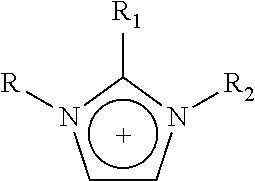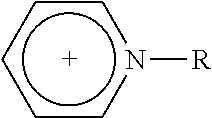Process of recovery of exhausted ionic liquids used in the extractive desulfurization of naphthas
a technology of exhausted ionic liquids and extraction desulfurization, which is applied in the direction of chemistry apparatus and processes, separation processes, and refining with aqueous alkaline solutions, etc., can solve the problems of large amounts of hydrogen, high capital investment and operating costs, and relatively high pressure, and achieve low toxicity, no vapor, and high temperature of decomposition
- Summary
- Abstract
- Description
- Claims
- Application Information
AI Technical Summary
Benefits of technology
Problems solved by technology
Method used
Image
Examples
example 1
1—First Cycle: Extractive Desulfurization with Fresh IL N-Methyl-N-Hexylimidazolium [HDMIM] Tetrachloroferrate FeCl4
In a glass reactor of 350 mL equipped with a magnetic stirring mechanism, 5.0 g of transparent light yellow IL of chloride of N-methyl-N-hexylimidazolium [HDMIM] Cl is introduced along with 6.0 g of anhydrous iron chloride for chemical reaction. The mixture is stirred for 10-20 minutes at room temperature to obtain a dark red liquid corresponding to IL N-methyl-N-hexylimidazolium [HDMIM] FeCl4 tetrachloroferrate. Obtained IL is mixed with 220 g of naphtha from the “Morelos” Gas Processor Centre of PEMEX. This naphtha originally contained a total sulfur concentration of 237 ppm. The two phase mixture is shaken vigorously for 10-20 minutes and it is left in rest for 10-60 minutes to improve the separation of the two liquid phases. A sample of 2 mL is taken from the top layer to be sent for total sulfur determination, which is carried out according to standard ASTM D 545...
example 2
1—First Cycle: Extractive Desulfuration with Fresh IL of N-Methyl-N-Hexylimidazolium Trichlorobromoaluminate, [HDMIM]AlBrCl3
1.5 g of transparent IL N-methyl-N-hexylimidazolium bromide and 1.2 g of aluminum chloride were added to a glass reactor with vigorous stirring during 10-20 minutes. After this reaction time, a dark red liquid corresponding to a N-methyl-N-hexylimidazolium trichlorobromoaluminate, [HDMIM]AlBrCl3, which was mixed with 54 g of natural gasoline obtained from a gas processing centre, containing 237 ppm of total sulfur.
Following the same steps described in the point 1 in Example 1, a sulfur content obtained with the fresh IL [HDMIM]AlBrCl3 was 4.7 ppm, corresponding to 98% of total sulfur removed with respect to the original sample.
1.1—Recovery of IL Exhausted
Exhausted IL was recovered by dilution with 5 mL of acetone, then, a soda solution was added until pH of 8-9. The transparent solution was a light yellow.
Water and acetone were removed by evaporation to obtain...
example 3
1—First Cycle: Extractive Desulfuration with Fresh IL of N-Butylpyridinium, Tetrachloroferrate [BuPy]FeCl4
1.5 g of transparent and light yellow N-butylpyridinium chloride and 2.1 g of iron (III) chloride were added to glass reactors of 100 mL with vigorous stirring during 10-20 minutes. After this reaction time, a dark red liquid corresponding to a N-butylpyridinium, [BuPy]FeCl4, which was mixed with 72 g of natural gasoline obtained from a gas processing centre, containing 237 ppm of total sulfur.
Following the same steps described in the point 1 in Example 1, a sulfur content obtained with the fresh IL [HDMIM]AlBrCl3 was 4.7 ppm, corresponding to 98% of total sulfur removed respect to the original sample.
1.1—Recovery of Depleted Ionic Liquid
Following the same steps of 1.1 in Example 1, 1.35 g of the IL precursor, N-butylpyridinium chloride, was obtained. This corresponds to a recovery of 90% efficiency.
The chemical structure of ionic liquid precursor N-butylpyridinium chloride was...
PUM
| Property | Measurement | Unit |
|---|---|---|
| temperatures | aaaaa | aaaaa |
| weight/weight ratio | aaaaa | aaaaa |
| pH | aaaaa | aaaaa |
Abstract
Description
Claims
Application Information
 Login to View More
Login to View More - R&D
- Intellectual Property
- Life Sciences
- Materials
- Tech Scout
- Unparalleled Data Quality
- Higher Quality Content
- 60% Fewer Hallucinations
Browse by: Latest US Patents, China's latest patents, Technical Efficacy Thesaurus, Application Domain, Technology Topic, Popular Technical Reports.
© 2025 PatSnap. All rights reserved.Legal|Privacy policy|Modern Slavery Act Transparency Statement|Sitemap|About US| Contact US: help@patsnap.com


